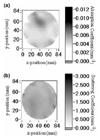Probing physiology and molecular function using optical imaging: applications to breast cancer
- PMID: 11250744
- PMCID: PMC150034
- DOI: 10.1186/bcr269
Probing physiology and molecular function using optical imaging: applications to breast cancer
Abstract
The present review addresses the capacity of optical imaging to resolve functional and molecular characteristics of breast cancer. We focus on recent developments in optical imaging that allow three-dimensional reconstruction of optical signatures in the human breast using diffuse optical tomography (DOT). These technologic advances allow the noninvasive, in vivo imaging and quantification of oxygenated and deoxygenated hemoglobin and of contrast agents that target the physiologic and molecular functions of tumors. Hence, malignancy differentiation can be based on a novel set of functional features that are complementary to current radiologic imaging methods. These features could enhance diagnostic accuracy, lower the current state-of-the-art detection limits, and play a vital role in therapeutic strategy and monitoring.
Figures




Similar articles
-
Translational optical imaging.AJR Am J Roentgenol. 2012 Aug;199(2):263-71. doi: 10.2214/AJR.11.8431. AJR Am J Roentgenol. 2012. PMID: 22826386 Review.
-
Hybrid time-domain and continuous-wave diffuse optical tomography instrument with concurrent, clinical magnetic resonance imaging for breast cancer imaging.J Biomed Opt. 2019 Jan;24(5):1-11. doi: 10.1117/1.JBO.24.5.051409. J Biomed Opt. 2019. PMID: 30680976 Free PMC article.
-
Advances in optical spectroscopy and imaging of breast lesions.J Mammary Gland Biol Neoplasia. 2006 Apr;11(2):165-81. doi: 10.1007/s10911-006-9022-4. J Mammary Gland Biol Neoplasia. 2006. PMID: 17091396 Review.
-
[Current methods of imaging in the diagnosis of breast cancer].Vopr Onkol. 1989;35(4):387-95. Vopr Onkol. 1989. PMID: 2658315 Review. Russian. No abstract available.
-
Nonmammographic breast imaging techniques. Current status and future developments.Obstet Gynecol Clin North Am. 1987 Sep;14(3):651-65. Obstet Gynecol Clin North Am. 1987. PMID: 3323969 Review.
Cited by
-
Three-dimensional, Bayesian image reconstruction from sparse and noisy data sets: near-infrared fluorescence tomography.Proc Natl Acad Sci U S A. 2002 Jul 23;99(15):9619-24. doi: 10.1073/pnas.112217899. Epub 2002 Jul 8. Proc Natl Acad Sci U S A. 2002. PMID: 12105269 Free PMC article.
-
Modern breast cancer detection: a technological review.Int J Biomed Imaging. 2009;2009:902326. doi: 10.1155/2009/902326. Epub 2009 Dec 28. Int J Biomed Imaging. 2009. PMID: 20069109 Free PMC article.
-
Fluorescent avidin-bound silver particle: a strategy for single target molecule detection on a cell membrane.Anal Chem. 2009 Feb 1;81(3):883-9. doi: 10.1021/ac801932m. Anal Chem. 2009. PMID: 19113832 Free PMC article.
-
Luminescent images of single gold nanoparticles and their labeling on silica beads.Opt Express. 2007 Oct 1;15(20):13415-20. doi: 10.1364/oe.15.013415. Opt Express. 2007. PMID: 19550610 Free PMC article.
-
Numerical modelling and image reconstruction in diffuse optical tomography.Philos Trans A Math Phys Eng Sci. 2009 Aug 13;367(1900):3073-93. doi: 10.1098/rsta.2009.0090. Philos Trans A Math Phys Eng Sci. 2009. PMID: 19581256 Free PMC article. Review.
References
-
- Svanberg K, Wang I, Colleen S, Idvall I, Ingvar C, Rydell R, Jocham D, Diddens H, Bown S, Gregory G, Montan S, Andersson-Engels S, Svanberg S. Clinical multi-colour fluorescence imaging of malignant tumours: initial experience. Acta Radiol. 1998;39:2–9. - PubMed
-
- Stepp H, Sroka R, Baumgartner R. Fluorescence endoscopy of gastrointestinal diseases: basic principles, techniques, and clinical experience. Endoscopy. 1998;30:379–386. - PubMed
-
- Sickles EA. Breast cancer detection with transillumination and mammography. Am J Roentgenol. 1984;142:841–844. - PubMed
Publication types
MeSH terms
Substances
LinkOut - more resources
Full Text Sources
Other Literature Sources
Medical

